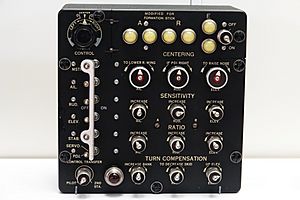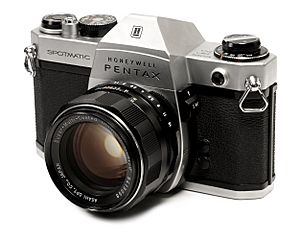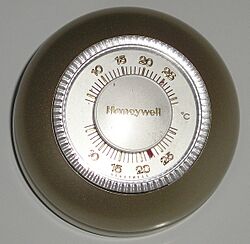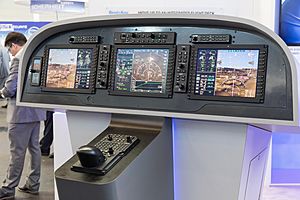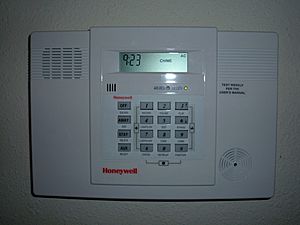Honeywell facts for kids
 |
|

|
|
| Public | |
| Traded as |
|
| Industry | Conglomerate |
| Predecessor |
|
| Founded | 1906 in Wabash, Indiana, U.S. |
| Founder | Mark C. Honeywell (for the Honeywell Inc. line) |
| Headquarters | Charlotte, North Carolina, U.S. |
|
Area served
|
Worldwide |
|
Key people
|
|
| Revenue | |
|
Operating income
|
|
| Total assets | |
| Total equity | |
|
Number of employees
|
102,000 (2024) |
| Subsidiaries |
|
Honeywell International Inc. is a large American company that works all over the world. It is based in Charlotte, North Carolina. Honeywell focuses on four main areas: things for airplanes (aerospace), making buildings smart (building automation), helping factories run smoothly (industrial automation), and finding ways to use energy better and protect the environment (energy and sustainability solutions). They also help run a special lab called Sandia National Laboratories for the U.S. Department of Energy. Honeywell is a very large company, ranked among the top 500 in the U.S. In 2024, they had about 102,000 employees worldwide. Vimal Kapur is the current chairman and chief executive officer.
The company's name, Honeywell International Inc., came from the joining of Honeywell Inc. and AlliedSignal in 1999. The combined company decided to keep the name "Honeywell" because many people already knew it. Honeywell was part of the Dow Jones Industrial Average stock index from 1999 to 2008. Before 1999, its earlier companies were included in the index since 1925.
In 2020, Honeywell rejoined the Dow Jones Industrial Average index. In 2021, it moved its stock listing from the New York Stock Exchange to the Nasdaq.
In 2025, Honeywell announced it would split into three separate companies: Honeywell Automation, Honeywell Aerospace, and Honeywell Advanced Materials.
Contents
- History of Honeywell
- Honeywell Heating Specialty Company Starts in 1906
- Company Growth and Mergers (1922–1934)
- Honeywell Goes Global (1934–1941)
- Honeywell During World War II
- New Products and Changes (1950–1970s)
- Company Changes and Mergers (1985–1999)
- Big Mergers and Takeovers (1999–2002)
- Growth Through Acquisitions (2002–2014)
- Recent Developments (2015–Present)
- Honeywell's Business Groups
- Honeywell's Leadership
- Companies Honeywell Has Bought Since 2002
- Environmental Efforts
- Images for kids
- See also
History of Honeywell
The Butz Thermo-Electric Regulator Company started in 1885. This was when Albert Butz invented the damper-flapper, a thermostat that controlled coal furnaces. This invention helped bring automated heating into homes. In 1886, he started his company. In 1888, Butz left the company. The company was then renamed the Consolidated Temperature Controlling Company.
Over the years, the company faced financial challenges and changed its name several times. In 1893, it became the Electric Heat Regulator Company. W.R. Sweatt, a stockholder, bought many patents and became a leader in the company. By 1900, Sweatt owned all the shares.
Honeywell Heating Specialty Company Starts in 1906
In 1906, Mark Honeywell started the Honeywell Heating Specialty Company in Wabash, Indiana. He wanted to make and sell his invention, the mercury seal generator.
Company Growth and Mergers (1922–1934)
As Honeywell's company grew, it bought Jewell Manufacturing Company in 1922. This helped them make their heating systems even better. Honeywell's company and the Minneapolis Heat Regulator Company (formerly Electric Heat Regulator Company) were competing. In 1927, the two companies joined together to form the Minneapolis-Honeywell Regulator Company. Mark Honeywell became the first president, and W.R. Sweatt became the first chairman.
By 1929, the combined companies were worth over $3.5 million. In 1931, Minneapolis-Honeywell started to grow more by buying the Time-O-Stat Controls Company. This gave them access to more patents for their control systems.
W.R. Sweatt and his son Harold led the company for 75 years. W.R. Sweatt helped turn a new idea, like controlling heating with a thermostat, into a successful business.
Honeywell Goes Global (1934–1941)
Harold Sweatt took over in 1934. He led Honeywell through a time of growth and expansion around the world. This helped Honeywell become a global leader in technology. Joining with the Minneapolis-Honeywell Regulator Company helped the company survive and thrive.
In 1934, Minneapolis-Honeywell started to enter the international market. They bought the Brown Instrument Company and began working with the Yamatake Company in Tokyo, Japan. Later in 1934, Minneapolis-Honeywell started selling its products in Canada and the Netherlands. This was their first office in Europe. They continued to grow internationally in 1936, opening an office in London and their first assembly plant in Canada. By 1937, ten years after the merger, Minneapolis-Honeywell had over 3,000 employees and made $16 million in sales each year.
Honeywell During World War II
When World War II started, the U.S. military asked Minneapolis-Honeywell for help with engineering and manufacturing projects. In 1941, Minneapolis-Honeywell created a better tank periscope, camera stabilizers, and the C-1 autopilot.
The C-1 autopilot made precision bombing much better. It was even used on the two B-29 bombers that dropped atomic bombs on Japan in 1945. Because these projects were so successful, Minneapolis-Honeywell opened an Aero division in Chicago on October 5, 1942. This division worked on things like the formation stick to control autopilots, more accurate fuel gauges for aircraft, and the turbo supercharger.
In 1950, Minneapolis-Honeywell's Aero division was hired to make controls for the first U.S. nuclear submarine, the USS Nautilus. In 1951, the company bought Intervox Company for its sonar, ultrasonic, and telemetry technologies. Honeywell also helped develop and make the RUR-5 ASROC for the U.S. Navy.
New Products and Changes (1950–1970s)
In 1953, Honeywell worked with the U.S. Air Force to create an automated control unit for aircraft. This unit could control an airplane through different parts of a flight, from moving on the ground to taking off. The pilot would then take over for landing. This system, called the Automatic Master Sequence Selector, worked like a player piano to give instructions to the aircraft's autopilot. This greatly reduced the pilot's work. Honeywell also developed the Wagtail missile with the U.S. Air Force.
From the 1950s to the mid-1970s, Honeywell was the company that imported Pentax cameras and photography equipment from Japan into the United States. These products were sold as "Heiland Pentax" and "Honeywell Pentax" in the U.S. In 1953, Honeywell introduced its most famous product, the T-86 Round thermostat.
In 1961, James H. Binger became Honeywell's president and later its chairman in 1965. Binger changed how the company sold its products, focusing more on making a profit than just selling a lot. He also increased the company's international growth. He officially changed the company's name from "Minneapolis-Honeywell Regulator Co." to "Honeywell" because that's what people commonly called it. Throughout the 1960s, Honeywell continued to buy other businesses, including Security Burglar Alarm Company in 1969.
In the 1970s, Honeywell focused on controls for industrial processes. Honeywell combined its computer operations with GE's information systems in 1970. Later, it bought GE's process control business. With this purchase, Honeywell took over GE's Multics operating system project. The design of Multics greatly influenced the Unix operating system. Honeywell, Groupe Bull, and Control Data Corporation also formed a joint company called Magnetic Peripherals Inc. which became a big player in the hard disk drive market.
Honeywell was a world leader in 14-inch disk drive technology in the 1970s and early 1980s. In the second half of the 1970s, Honeywell started looking at international markets again. It bought the French company Compagnie Internationale pour l’Informatique in 1976. In 1984, Honeywell created Honeywell High Tech Trading to help other companies sell their products abroad. Under Binger's leadership from 1961 to 1978, he expanded the company into areas like defense, aerospace, and computing.
During and after the Vietnam Era, Honeywell's defense division made many products. The Honeywell project, started in 1968, organized protests against the company to try and convince it to stop making weapons.
In 1980, Honeywell bought Incoterm Corporation to compete in airline reservation systems and bank teller markets.
Honeywell Information Systems
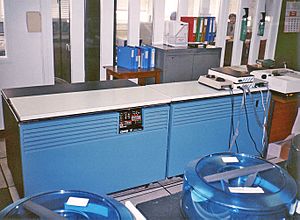
In April 1955, Minneapolis-Honeywell started a joint company with Raytheon called Datamatic. They wanted to enter the computer market and compete with IBM. In 1957, their first computer, the DATAmatic 1000, was sold and installed. By the time the DATAmatic 1000 was released, Minneapolis-Honeywell had bought Raytheon's share in Datamatic. They turned it into the Electronic Data Processing division, later called Honeywell Information Systems (HIS).
Honeywell bought a company called Computer Control Corporation (3C's) in 1966. They renamed it Honeywell's Computer Control Division. Through most of the 1960s, Honeywell was one of the "Snow White and the Seven Dwarfs" of computing. IBM was "Snow White," and the "dwarfs" were seven smaller computer companies, including Honeywell. Later, when there were only five, they were known as "The BUNCH".
In 1970, Honeywell bought GE's computer business. They renamed GE's 600-series mainframes to Honeywell 6000 series computers. These computers supported GCOS, Multics, and CP-6. This also formed Honeywell Information Systems. In 1973, they shipped a fast printer called the Honeywell Page Printing System.
From 1974 to 1987, under CEO Edson W. Spencer, the company started to move away from computers. Instead, they focused on aeronautics (things related to aircraft) and industrial technology. In 1975, it bought Xerox Data Systems. Some of Honeywell's systems were minicomputers, like their Series 60 Model 6 and Model 62 and their Honeywell 200. In 1987, HIS joined with Groupe Bull, a global company with Compagnie des Machines Bull of France and NEC Corporation of Japan. This new company became Honeywell Bull. By 1991, Honeywell was no longer involved in the computer business.
Company Changes and Mergers (1985–1999)
Aerospace and Defense
In 1986, Honeywell took a new direction by buying the Sperry Aerospace Group from the Unisys Corporation. In 1990, Honeywell separated its Defense and Marine Systems business into Alliant Techsystems. They also spun off their Test Instruments division. This was done to help the company focus better. Honeywell still provides aerospace products like electronic guidance systems, cockpit instruments, lighting, and aircraft engines. In 1996, Honeywell bought Duracraft and started selling its products for home comfort.
Honeywell is part of the group that runs the Pantex Plant. This plant assembles all the nuclear bombs in the United States. Honeywell Federal Manufacturing & Technologies operates the Kansas City Plant. This plant makes and assembles 85 percent of the non-nuclear parts of the bombs.
Home and Building Controls
Honeywell started the SmartHouse project. This project aimed to combine heating, cooling, security, lighting, and appliances into one easy-to-control system. They continued this trend in 1987 by releasing new security systems, fire detectors, and radon detectors. In 1992, Honeywell combined its Residential Controls, Commercial Systems, and Protections Services divisions into Home and Building Control. This group then bought the Enviracare air cleaner business. By 1995, Honeywell had three main divisions: Space and Aviation Control, Home and Building Control, and Industrial Control.
Industrial Control
Honeywell ended its partnership with Yamatake Company. In 1998, it combined its Process Control Products Division, Process Management System Division, and Micro Switch Division into one Industrial Control Group. It also bought Measurex System and Leeds & Northrup in 1997 to make its product range stronger.
Big Mergers and Takeovers (1999–2002)
AlliedSignal and Pittway
On June 7, 1999, Honeywell was bought by AlliedSignal. AlliedSignal decided to keep the Honeywell name because it was so well-known. The former Honeywell company moved its headquarters, which had been in Minneapolis for 114 years, to AlliedSignal's headquarters in Morristown, New Jersey. Even though it looked like AlliedSignal bought Honeywell, it was seen as a merger of equals. AlliedSignal's sales in 1998 were $15.1 billion, while Honeywell's were $8.4 billion. Together, the companies had large business interests in aerospace, chemical products, car parts, and building controls.
When Honeywell closed its headquarters in Minneapolis, over a thousand employees lost their jobs. Some moved to Morristown or other company locations, but most had to find new jobs or retire. Soon after the merger, the company's stock price dropped significantly. It did not return to its previous level until 2007.
In 2000, the new Honeywell bought Pittway for $2.2 billion. This was to get a bigger share of the fire-protection and security systems market. Pittway was merged into Honeywell's Home and Building Control division. Pittway's Ademco products fit well with Honeywell's existing control systems.
General Electric Company
In October 2000, Honeywell, which was worth over $21 billion, agreed to be bought by General Electric, led by its CEO Jack Welch. The American Department of Justice approved the merger. However, on July 3, 2001, the European Commission's competition commissioner, Mario Monti, stopped the deal. This decision was made because GE was very strong in the large jet engine market, and Honeywell had regional jet engines and avionics (electronics for aircraft). The European Commission believed the new company could combine products and stop other companies from competing fairly.
U.S. regulators disagreed. They thought the merger would increase competition and lower prices. This disagreement caused low morale and confusion within Honeywell. The CEO at the time, Michael Bonsignore, was fired as Honeywell tried to improve its business.
Growth Through Acquisitions (2002–2014)
In January 2002, Knorr-Bremse took full ownership of its joint ventures with Honeywell in Europe, Brazil, and the USA. Bendix Commercial Vehicle Systems became a part of Knorr-Bremse AG.
In February 2002, Honeywell's board chose David M. Cote as their next CEO and chairman. Since 2002, Honeywell has bought more than 80 companies and sold 60. As a result of these acquisitions, its workforce grew to 131,000 employees. Honeywell's stock price nearly tripled from $35.23 in April 2002 to $99.39 in January 2015.
Honeywell made a bid of £1.2 billion ($2.3 billion) for Novar plc in December 2004. This purchase was completed in March 2005. In October 2005, Honeywell bought Dow's 50% share in UOP for $825 million. This gave them full control over the joint company that worked on petrochemical and refining technology. In May 2010, Honeywell bought the French company Sperian Protection for $1.4 billion. This company was then added to Honeywell's automation and controls safety unit.
Recent Developments (2015–Present)
In 2015, Honeywell's headquarters moved to Morris Plains, New Jersey. The headquarters included a large building on 40 acres.
In December 2015, Honeywell bought Elster for US$5.1 billion. This brought them into the business of gas, electricity, and water meters, especially smart meters. In January 2016, Honeywell International Inc. bought the remaining 30% of UOP Russell LLC for about $240 million.
In April 2016, Honeywell bought Xtralis for $480 million. Xtralis provides smoke detection, security technologies, and video analysis software. In May 2016, Honeywell International Inc. settled a patent dispute with Google's Nest Labs. Honeywell had claimed that Nest's thermostats copied some of its patents. Google's parent company, Alphabet Inc., and Honeywell announced they had reached an agreement that solved the long-standing dispute. In 2017, Honeywell opened a new software center in Atlanta, Georgia.
David Cote stepped down as CEO on April 1, 2017. He was replaced by Darius Adamczyk, who had been promoted to president and chief operating officer (COO) in 2016. Cote served as executive chairman until April 2018. In October 2017, Honeywell announced plans to separate its Homes, ADI Global Distribution, and Transportation Systems businesses into two separate, publicly traded companies by the end of 2018.
In 2018, Honeywell spun off both Honeywell Turbo Technologies, now Garrett Advancing Motion, and its consumer products business, Resideo. Both companies are now traded publicly on the New York Stock Exchange. For the year 2019, Honeywell reported sales of US$36.709 billion.
Honeywell moved its main corporate headquarters to Charlotte, North Carolina, in October 2019. In July 2019, Honeywell employees moved into a temporary headquarters building in Charlotte before their new building was finished.
In 2020, Honeywell Forge was launched. This is a software platform for analyzing data in industrial and commercial areas, such as aircraft, buildings, factories, worker safety, and cybersecurity. Honeywell Robotics was also created in Pittsburgh, working with Carnegie Mellon University, to focus on improving supply chains. The Honeywell robotic unloader can grab packages in large trucks and place them on conveyor belts for workers to sort.
In May 2019, GoDirect Trade launched as an online marketplace for extra aircraft parts like engines and electronics. In March 2020, Honeywell announced that its quantum computer uses trapped ions. Its expected quantum volume is at least 64, which Honeywell's CEO called the world's most powerful quantum computer. In November 2021, Honeywell announced that its quantum division would become a separate company called "Quantinuum".
In March 2023, Honeywell announced Vimal Kapur as its next CEO, starting June 1, 2023. In December 2023, Honeywell bought Carrier Global's security business.
In February 2024, Honeywell filed a lawsuit against Lone Star Aerospace, Inc., claiming their software products copied five of Honeywell's patents.
On October 1, 2024, Honeywell partnered with Google to combine data with generative AI. The goal is to make operations more automated for its customers.
On October 8, 2024, it was announced that the company's advanced materials division would be spun off into a new company.
On February 6, 2025, it was announced that Honeywell would be split into three independent companies. This decision came after an activist investor took a large share in the company and supported the split. Its aerospace, automation, and previously announced advanced materials segments will become separate companies.
On May 22, 2025, the company announced it was buying Johnson Matthey's Catalyst Technologies business for £1.8 billion.
Honeywell's Response to COVID-19
During the COVID-19 pandemic, Honeywell changed some of its factories in Rhode Island, Arizona, Michigan, and Germany. They started making personal protective equipment for healthcare workers. In April 2020, Honeywell began making N95 masks at its factories in Smithfield and Phoenix. Their goal was to produce 20 million masks a month. Honeywell's facilities in Muskegon and Germany were changed to produce hand sanitizer for government agencies.
Several state governments hired Honeywell to make N95 masks during the pandemic. For example, the North Carolina Task Force for Emergency Repurposing of Manufacturing gave Honeywell a contract for 100,000 N95 masks each month. In April 2020, Los Angeles Mayor Eric Garcetti announced a deal with Honeywell to produce 24 million N95 masks for healthcare workers and first responders.
In May 2020, U.S. President Donald Trump visited the Honeywell Aerospace Technologies facility in Phoenix. He praised the "incredibly patriotic and hard-working men and women of Honeywell" for making N95 masks. He called the company's production a "miraculous achievement."
In April 2021, Will.i.am and Honeywell worked together on Xupermask. This mask was made of silicon and athletic mesh fabric. It had LED lights, 3-speed fans, and noise-canceling headphones.
In November 2024, Honeywell announced it planned to sell its personal protective equipment business to Protective Industrial Products for almost $1.33 billion. This sale is expected to be completed by the first half of 2025.
After selling the PPE business, the company plans to keep its gas detection products.
Honeywell's Business Groups


Honeywell has four main business groups: Honeywell Aerospace Technologies, Building Automation, Safety and Productivity Solutions (SPS), and Performance Materials and Technologies (PMT). Here's what each group does:
- Honeywell Aerospace Technologies makes parts for airplanes, like engines, flight systems, and other solutions. They work with aircraft makers, airlines, airports, militaries, and space programs. This group includes Commercial Aviation, Defense & Space, and Business & General Aviation. In January 2014, Honeywell Aerospace Technologies launched its SmartPath Precision Landing System at Malaga-Costa del Sol Airport in Spain. This system uses GPS signals to help planes land more accurately.
* In July 2014, Honeywell's Transportation Systems joined the Aerospace division because their businesses were similar. In April 2018, Honeywell announced plans to develop laser communication products for satellites with Ball Aerospace. In June 2018, Honeywell spun off and renamed its Transportation Systems as Garrett.
- Building Automation and Honeywell Safety and Productivity Solutions were created in July 2016 when Automation and Control Solutions was split into two. Building Automation includes Honeywell Building Solutions, Environmental and Energy Solutions, and Honeywell Security and Fire. In December 2017, Honeywell announced it had bought SCAME, an Italian company. This added new fire and gas safety products to its offerings.
- Honeywell Safety and Productivity Solutions includes Scanning & Mobility, Sensing and Internet of Things, and Industrial safety.
- Honeywell Performance Materials and Technologies has six business units: Honeywell UOP, Honeywell Process Solutions, Fluorine Products, Electronic Materials, Resins & Chemicals, and Specialty Materials. Their products include technology for processing oil and gas, fuels, films, special chemicals, electronic materials, and renewable transportation fuels.
Honeywell's Leadership
Honeywell's current chief executive officer is Vimal Kapur. As of June 2023, the members of the board are:
| Vimal Kapur | Chief executive officer |
| Darius Adamczyk | Chairman |
| Duncan B. Angove | Chief Executive Officer of Arcspring LLC |
| William S. Ayer | Retired chairman of the board and chief executive officer of Alaska Air Group |
| Kevin Burke | Non-executive chairman of Consolidated Edison, Inc. (Con Edison) |
| Deborah Flint | President and chief executive officer of the Greater Toronto Airports Authority (GTAA) |
| D. Scott Davis | Chairman and chief executive officer of United Parcel Service, Inc. (UPS) |
| Rose Lee | President and CEO Cornerstone Buildings Brands |
| Grace D. Lieblein | Vice president of global purchasing and supply chain of General Motors Corporation (GM) |
| Robin L. Washington | Executive vice president and chief financial officer of Gilead Sciences, Inc. |
| Robin Watson CBE | Former chief executive officer of Wood Plc |
Companies Honeywell Has Bought Since 2002
Honeywell has mostly bought businesses that fit with its existing technologies. The companies they bought are added to one of Honeywell's five business groups (Aerospace Technologies (AT), Building Automation (BA), Safety and Productivity Solutions (SPS), Energy and Sustainability Solutions (ESS), or Performance Materials and Technologies (PMT)). However, they often keep their original brand name.
| Year | Acquisition | Business Group |
|---|---|---|
| 2023 | LenelS2
Supra Onity |
BA |
| 2021 | Sparta Systems | PMT |
| 2020 | Sine Group | BA |
| Ballard Unmanned Systems | AT | |
| 2019 | Tru-Trak Flight Systems | AT |
| Rebellion Photonics | SPS | |
| 2018 | Transnorm | SPS |
| 2017 | Nextnine | PMT |
| SCAME Sistemi | BA | |
| FLUX | SPS | |
| 2016 | Com Dev | AT |
| RSI | BA | |
| Intelligrated | SPS | |
| Xtralis | BA | |
| Movilizer | SPS | |
| UOP Russell LLC | PMT | |
| 2015 | Seelze | PMT |
| Elster | PMT | |
| Aviaso | AT | |
| Datamax-O'Neil | SPS | |
| 2013 | Saia Burgess Controls | BA |
| Intermec | SPS | |
| RAE Systems | SPS | |
| 2012 | Fire Sentry | BA |
| InnCom | BA | |
| Thomas Russell LLC | PMT | |
| 2011 | EMS | SPS/AT |
| Iris Systems | BA | |
| Kings Safety Shoes | SPS | |
| 2010 | Akuacom | BA |
| Matrikon | PMT | |
| E-Mon | BA | |
| Sperian | SPS | |
| 2009 | RMG | PMT |
| Cythos | SPS | |
| 2008 | AV Digital Audio-Videotechnik GmbH | BA |
| Energy Services Group, LLC | PMT | |
| Metrologic | SPS | |
| IAC | AT | |
| Callidus | PMT | |
| Norcross | SPS | |
| 2007 | Plant Automation Systems, Inc. (PAS) | PMT |
| Dimensions Int'l | AT | |
| ActiveEye | SPS | |
| Burtek | PMT | |
| Ex-Or | BA | |
| Enraf Holdings B.V. | SPS | |
| Handheld Products | SPS | |
| Maxon Corporation | PMT | |
| 2006 | Sempra Energy Services | PMT |
| First Technology | SPS | |
| Gardiner Group | BA | |
| 2005 | Honeywell UOP | PMT |
| Novar Controls | BA | |
| Zellweger | SPS | |
| Lebow | SPS | |
| Friedland | BA | |
| InterCorr International, Inc. | SPS | |
| Tridium, Inc. | BA | |
| 2004 | Hymatic Group | AT |
| Genesis Cable | BA | |
| HomMed, LLC | SPS | |
| Aube Technologies | BA | |
| Vindicator | BA | |
| Electro-Radiation Incorporated (ERI) | AT | |
| Edgelinx | BA | |
| GEM Microelectronics | PMT | |
| 2003 | Silent Witness | BA |
| Sensotec | SPS | |
| Baker Electronics | AT | |
| Gamewell | BA | |
| Olympo | BA | |
| FutureSmart | BA | |
| Kolon Films | PMT | |
| Betatech | BA | |
| 2002 | Invensys Sensor Systems | SPS |
| Chadwick Helmuth | AT | |
| Ultrak | BA | |
| Mora Moravia | AT | |
| Shanghai Alarm | BA |
Environmental Efforts
The United States Environmental Protection Agency (EPA) has noted that Honeywell has been connected to many Superfund sites, which are places with toxic waste. In 2007, Honeywell was listed among U.S. companies that released a lot of air pollution. In 2001, Honeywell agreed to pay $150,000 in fines and spend $772,000 on repairs for environmental violations. These included not fixing leaks of harmful pollutants into the air and not reporting equipment that contained certain chemicals.
In 2003, a judge ordered the company to spend about $400 million to clean up chromium waste. This waste was causing "substantial risk" to public health and the environment. In 2003, Honeywell paid $3.6 million to avoid a trial about water contamination in Lisle, Illinois. In 2004, the State of New York required Honeywell to complete a $448 million cleanup of mercury and other toxic waste. This waste was dumped into Onondaga Lake in Syracuse, New York, from an old chemical property.
Honeywell built three water treatment plants by November 2014. The chemical cleanup removed 7 tons of mercury. In November 2015, Audubon New York gave Honeywell an award for its cleanup efforts. By December 2017, Honeywell finished cleaning the lake. Later that December, the Department of Justice required Honeywell to pay an additional $9.5 million in damages. They also had to build 20 restoration projects along the shore to help repair the area around the lake.
In 2005, the state of New Jersey sued Honeywell and other companies. They wanted them to clean up over 100 sites contaminated with chromium, a metal linked to health issues. In 2008, the state of Arizona reached an agreement with Honeywell. Honeywell paid a $5 million fine and contributed $1 million to a local air-quality cleanup project. This was after claims that they broke water-quality and hazardous-waste laws many times between 1974 and 2004.
In 2006, Honeywell announced that stopping the making of mercury switches led to big reductions in mercury, lead, and chromic acid use. The EPA recognized Honeywell's leadership in reducing mercury use with an award in 2006.
Carbon Footprint
Honeywell reported its total CO2e emissions (direct and indirect) for the twelve months ending December 31, 2020, at 2,248 kilotonnes. Honeywell aims to reach net zero emissions by 2035.
| Dec 2014 | Dec 2015 | Dec 2016 | Dec 2017 | Dec 2018 | Dec 2019 | Dec 2020 |
|---|---|---|---|---|---|---|
| 5,760 | 5,262 | 4,218 | 2,584 | 2,528 | 2,337 | 2,248 |
Images for kids
See also
 In Spanish: Honeywell para niños
In Spanish: Honeywell para niños
- List of Honeywell products and services
- Top 100 US Federal Contractors



